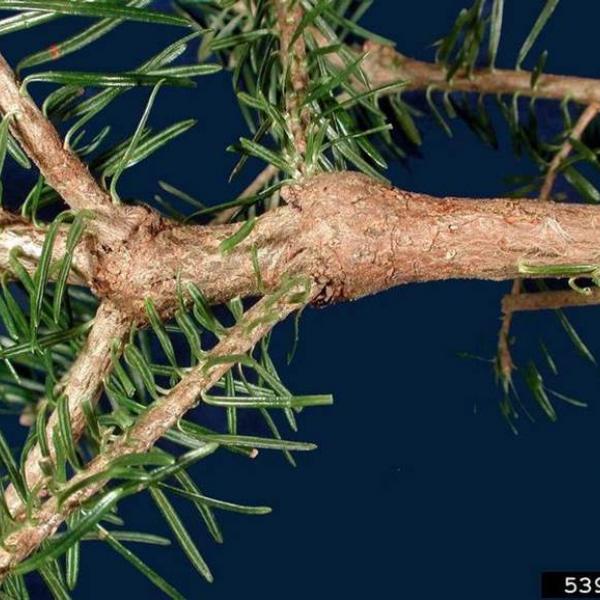
The balsam woolly adelgid is an invasive insect that attacks true firs (Abies, spp) in eastern and western forests. In Vermont, the native balsam fir and a commonly used Christmas tree, Fraser fir, are susceptible. This insect originated in Europe; probably first arriving in the northeast around 1900. It has been reported in Vermont for many years. In 2015, scattered reports of balsam fir mortality from throughout the state were received. Some of this mortality has been attributed to balsam woolly adelgid (BWA).
Like its Asian cousin, hemlock woolly adelgid, BWA is a tiny sucking insect that covers itself with white, waxy flocculence. This white fluff hides an adult and protects its eggs from desiccation. It is often found on the trunk, around branch and twig nodes or near the buds.
The life cycle of balsam woolly adelgid is complex and varies depending on location, elevation and climate. In New England two generations per year is most common. The adults are all female and reproduction is parthenogenetic – that is, eggs are produced that do not need to be fertilized. Stubby- legged hatchlings, known as crawlers, are the only growth stage capable of directed movement. Crawlers seek a feeding site where they insert their mouthparts and begin to feed. As they feed, BWA develop without molting and become “neosistens”, an overwintering, resting stage that precedes two more immature stages and then the adult.
As it feeds, the adelgid injects a substance that effects cell growth and causes feeding injury. European firs are not very sensitive to feeding injury but, our Vermont firs respond in two ways. This abnormal growth manifests as swelling or “gouting” of twigs, when the feeding attack is near the bud or twig nodes. This stunts the growth of twigs and branches in the fastest growing parts of the crown and leads to prolonged decline. Trees may take on a characteristic “fiddle shape” or “top curl”. Eventually these declining, stressed tops may succumb to other pests, like fungi.
When feeding occurs on the tree’s main stem, another response is elicited, which often leads to more serious damage. Thick, irregular, reddish cells form unusual growth rings that are sometimes referred to as “rotholz”. These rings don’t conduct water well. Trees with this kind of damage to the bole of the tree may die in 2-3 years. Heavy stem infestations will look fuzzy and may feature as many as 200 BWA per square inch. Stem infested balsam and Fraser fir foliage will typically turn yellow, then deep brown. In New England, balsam fir can exhibit both gouting of twigs and stem attacks but, Fraser generally suffers only from stem attack.
To date BWA has caused only scattered, sporadic damage throughout Vermont. This may owe to the fact that without wings, they are not very mobile. They rely on the wind and to a lesser degree birds and other animals for dispersal. Furthermore, balsam woolly adelgid is susceptible to cold and cannot survive on dead trees, so its populations have often collapsed by the time symptoms are observed.
There are no practical control methods for forest stands infested with balsam woolly adelgid. High value landscape specimens and Christmas trees can be protected with chemical treatments and to some degree by cultural activities to manipulate the tree’s environment.
Article by Jim Esden, VT Dept of Forests, Parks, and Rec
Photo by Ronald S. Kelley, Vermont Department of Forests, Parks and Recreation, Bugwood.org